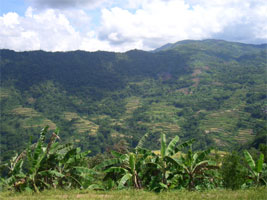Two significant mineralization styles were recognized at the Batong Buhay area namely, porphyry copper-gold and high sulphidation quartz-enargite gold vein mineralization. The high sulphidation-type mineralization and associated advance argillic alteration was observed to be superimposed on the earlier porphyry Cu-Au mineralization and alteration.
PORPHYRY CU-AU
At least two porphyry Cu-Au orebodies are found in the area. These are the Dickson and Malinao orebodies. These deposits are mainly hosted by sericite-day-chlorite-altered quartz diorite to tonalite porphyry.
The Dickson porphyry Cu-Au deposit has a high grade core with a diameter of 220 m and average assays of 1.43% Cu and 1.33 gpt Au, enveloped by an outer shell of 0.5% Cu. At the surface, the deposit shows primary chalcopyrite and secondary chalcocite+covellite+malachite mineralization. The Malinao orebody is roughly tabular in shape with dimensions of 800 m by 250 m. The primary copper mineral is chalcopyrite which is altered to secondary chalcocite, malachite and azurite.
HIGH SULPHIDATION QUARTZ-ENARGITE GOLD VEINS
There are gold-rich quartz veins encountered north and south of the Dickson and Malinao orebodies. These veins trend NS to NNW with widths ranging from 1 to 9 m. The veins are vuggy, chalcedonic and contain chalcopyrite, enargite, covellite and tennantite. The vein is hosted in advance argillic altered tonalite porphyry and basalt


